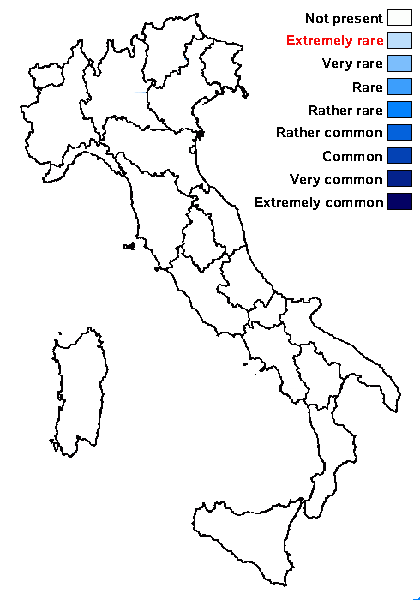Opegrapha anomea Nyl.
Act. Soc. Linn. Bordeaux 21, 4: 399, 1857.
Synonyms:
Distribution:
Description: Thallus inapparent, not lichenized, growing on the thalli of Pertusaria- and Ochrolechia-species. Apothecia round to angular or ellipsoid, 0.1-0.3 mm across, partly immersed in the host thallus and breaking through its cortex, with a convex, black, epruinose, verruculose disc, usually gathered into up to 4 mm wide clusters. Proper exciple dark brown, K-, not extending below the hymenium; epithecium brownish, K-; hymenium colourless, K+, I+ blue turning red, K/I+ blue; paraphysoids branched and anastomosing, 2-2.5 μm thick, the apical cells hardly swollen; subhymenium colourless; hypothecium brown. Asci 4(-8)-spored, subclavate, the wall I-, K/I-, except for an apical K/I+ blue ring-structure in tholus. Ascospores 3-septate, slightly constricted at the median septum, hyaline but turning brown and coarsely verrucose at maturity, elongate-ellipsoid, 17-26 x 6.5-9 μm, with a distinct, c. 0.5 μm thick gelatinous perispore. Pycnidia black, immersed, located among the apothecia. Conidia narrowly bacilliform, 3.5-4 x 0.5-0.7 μm. Photobiont absent. Spot tests: K-, C-, KC-, P-. Chemistry: without lichen substances.Note: a lichenicolous fungus growing on the thalli of Pertusaria- and Ochrolechia-species; to be looked for in Italy.
Growth form: Lichenicolous fungus
Substrata: bark and rocks
Reproductive strategy: mainly sexual

Predictive model
Growth form: Lichenicolous fungus
Substrata: bark and rocks
Reproductive strategy: mainly sexual

Predictive model
 Index Fungorum
Index Fungorum
 GBIF
GBIF

